Key lessons from a world-leading Decision Science conference
- Centre for Decision Research
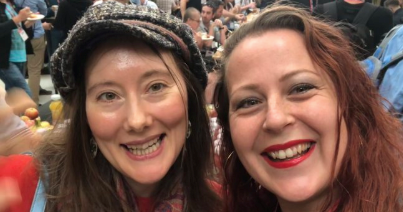
For my research, I regularly attend conferences and events to present my research findings and network with other researchers in my field. I recently presented at the Subjective Probability, Utility, and Decision Making (SPUDM) Conference in Amsterdam, in August 2019, along with fellow members of the Centre for Decision Research (CDR).
Our main reasons for attending this conference were to:
- Present our latest research results
- Stay up-to-date with current decision making research
- Create and maintain international collaborations with researchers.
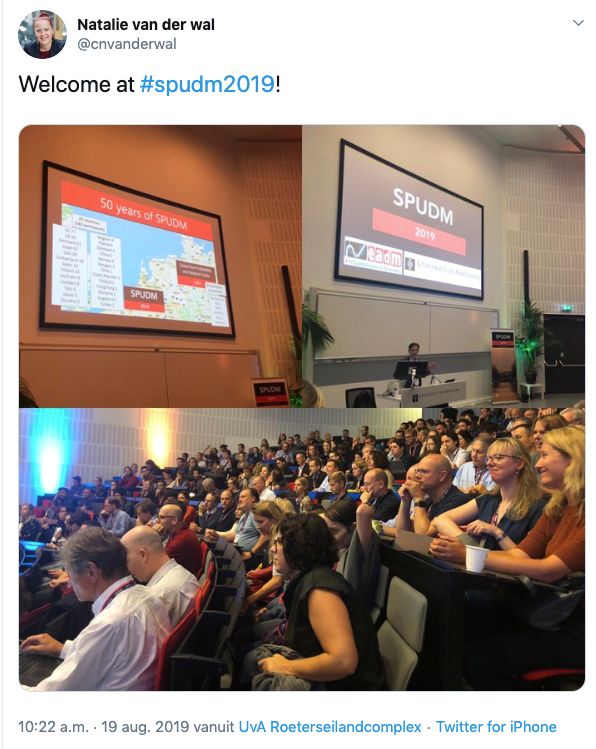
Why SPUDM?
The International Conference on Subjective Probability, Utility and Decision Making (SPUDM) is one of the main conferences in Decision Research. One of the objectives of the Centre for Decision Research is to create world-leading multi-disciplinary research that has a large impact on society. Presenting our work at major international conferences is part of our strategy to create and maintain our international collaborations and international impact on society.
Every year we have numerous members presenting their latest research at this conference. This year the conference had eleven papers by CDR members, presented by: Andrea Taylor, Astrid Kause, Barbara Summers, Gabriella Eriksson, Manos Konstantinidis, Yasmina Okan, Wändi Bruine de Bruin, as well as visiting professor Eric Stone and also myself.
What is decision research?
There are different types of decision research: normative, descriptive and prescriptive.
- Normative decision theories aim to identify how decisions should ideally be made to obtain the best outcomes
- Descriptive research aims to understand how decisions are actually made, and to identify deviations from normative theories
- Prescriptive research aims to address potential problems in decision making so as to promote better outcomes.
Current members of the CDR are providing important insights into how and why people do what they do in different domains. For example, in health, finance, safety and climate change, with topics including: cancer risk communication, age differences in decision making, dealing with debts, drivers’ decisions to speed, confidence in experienced decision making, evacuation decisions, and time-pressured decision making in the workplace.
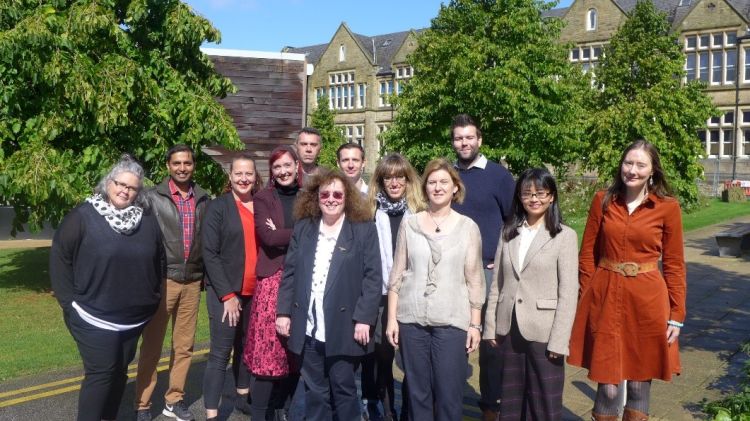
Current Members of the Centre for Decision Research.
(L-R): Nicola Bown, Sajid Siraj, Natalie van der Wal, Wändi Bruine de Bruin, Panagiotis Stamolampros, Barbara Summers, Romain Crastes, Yasmina Okan, Gulbanu Kaptan, Richard Hodgett, Xingjie Wei, Andrea Taylor.
Preparing for the conference
My colleagues and I made a list of all the talks we were giving at the conference so we could see and support each other. As I planned to live-tweet, I also made notes on all the other talks I wanted to see and did some research on who the keynote speakers were and what their research is about. I was looking forward to meeting researchers in the field of decision science, which is related to what I do but I have not previously had the chance to network with researchers in this field. I’m glad I had the opportunity to do so at the conference.
Presentations from members of the Centre for Decision Research
Savouring the good things – Professor Wändi Bruine de Bruin
One of the eye-opening lessons I learned during this presentation is that loneliness is not only present in the elderly; it actually is just as present amongst teenagers and young adults. Professor Wändi Bruine de Bruin presented her work showing older adults tend to have better emotional well-being (including less sadness and loneliness) than younger adults, and are better at savoring the good things that happen in life. I think we need older people to teach younger people on how to savour the good things and focus less on negative events.
Knowing your carbon footprint – Dr Astrid Kause
The second key lesson for me was about ways to lower the carbon foot print of my food choices. Dr Astrid Kause presented her work on how many rules people can come up with to lower their carbon footprint. I was surprised to hear that consumers only come up with one or two rules, but then realised I could only think of a couple too. Here are the top three rules participants in Astrid’s study came up with: ‘buy local’, ‘reduce packaging’ and ‘buy organic’. However, according to climate and environmental scientists these are of limited effectiveness for lowering the carbon footprint of food. According to their studies, it is much more effective to ‘replace animal proteins with plant-based proteins’ or to ‘buy fruits and vegetables grown outside’ (not from a greenhouse).
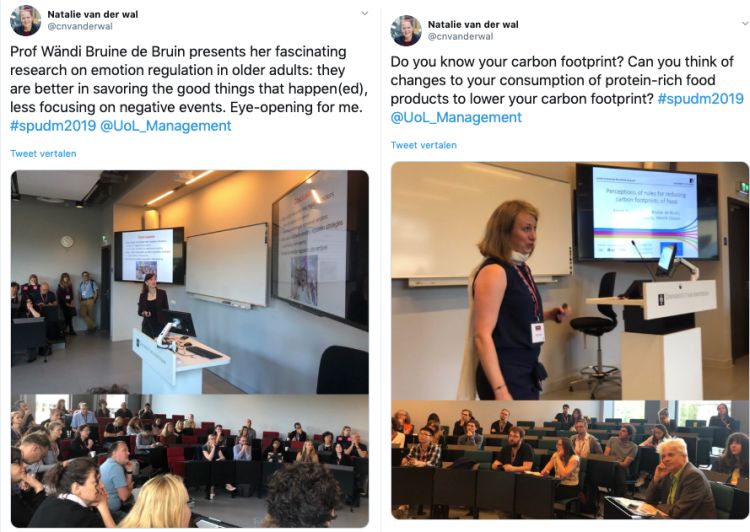
Risk communications related to the weather – Dr Andrea Taylor
Dr Andrea Taylor presented her work on risk communications related to the weather. She found that the yellow and amber warning level predicts anticipated risk but not action. I would have expected people to take action as soon as there was a warning, but this is not the case!
Being risk-averse or risk-taking when making decisions for yourself or others – Visiting Professor Eric Stone
I really liked Professor Eric Stone’s introduction: would you ask someone to dance with you? And would you tell your friend to ask that person to dance with you? In a meta-analysis he found no overall difference in whether people took more risks for others than for themselves. When looking at moderators, he found that the domain or context influences the decisions you make. For example you take more risk for others when it comes to asking someone to dance, but you are more risk averse when you have to make a health or safety decision for another person.

Confidence in decision making - Dr Manos Konstantinidis
Dr Manos Konstantinidis presented his interesting work on confidence in decision making. In his study participants learnt which option is the best over time (through rewards) in a learning task and asked them how confident they were that they had chosen the best option. From his presentation I learnt that we can use confidence ratings to improve our predictions about which choices people make and that it also can give us an insight into the uncertainty people are facing when making decisions.
Knowing your graph literacy – Dr Yasmina Okan
Dr Yasmina Okan also presented her important work on determining if people can understand graphs in health communications easily or not. She found that when people see graphs about health risks, those with higher graph literacy tend to understand the risks better and often perceive them as less severe. She also developed a new 4-item scale that provides a quick and simple way to measure people’s graph literacy and identify those who may be at risk of misinterpreting commonly used graphs.
Driver decisions on speeding – Dr Gabriella Eriksson
Drs Gabriella Eriksson and Yasmina Okan presented their work on improving risk communication for health and decreasing speeding behaviour in drivers with a poster. They had lots of interaction with visitors at the conference to disseminate their results.
Gabriella explained that she investigated how drivers perceive accident risks and decisions to speed by interviewing drivers in the UK and Sweden. Speeding was the second most identified risk factor across interviewees. Most interviewees reported that the reason for speeding was being in a hurry, feeling safe in the car and enjoying the speed. There were some misconceptions about what speeding means. Most interviewees considered speeding as going faster than the speed limit, but some interviewees considered speeding to be driving up to 40 miles per hour over the speed limit!
The effect of time pressure on decision making – Professor Barbara Summers
Professor Barbara Summers gave an interesting talk on time pressure during decision making. She presented the most used strategies amongst managers in the workplace when working under time pressure: filtering (choose only the most important/critical aspects of the problem), acceleration (working faster), asking for help, ignoring the deadline, using your gut feeling and working longer. I found it really interesting to see what others do under time pressure. Personally, I am motivated to work hard when a deadline is approaching, but I always prefer to work when there is no time pressure.
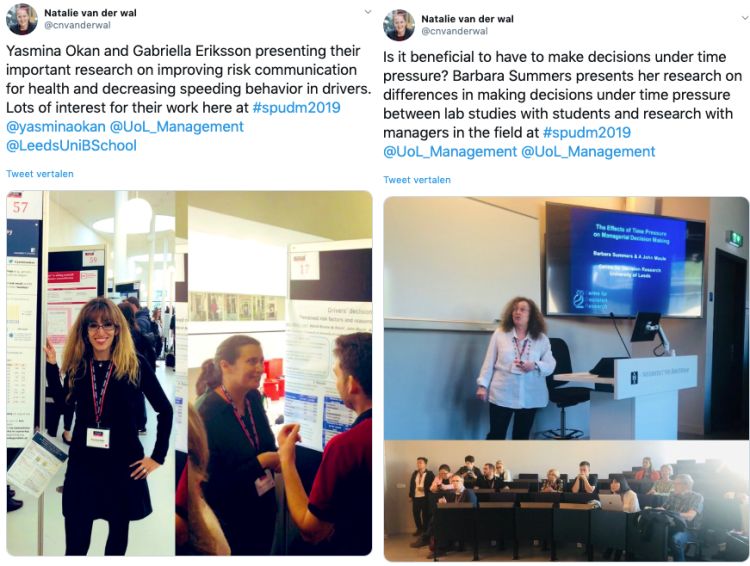
Evacuation decision making in relation to evacuation communications – Dr Natalie Van Der Wal
I presented my work on evacuation communications and human behaviours during emergency evacuations: how are they related? I found that there was a more delayed response (e.g. when people do not immediately start to move to the exits when an alarm sounds) when the alarm is sounding, but less when staff members are present to guide people to exits. This means that in practice, it is important to train staff members in evacuation procedures. Only using an alarm does not seem to be beneficial for an efficient evacuation.
I very much enjoyed presentations by the keynote speakers and other presenters, including Professor Cristina Bicchieri’s research on lying (University of Pennsylvania); Professor Anna Dreber’s research on the importance and methodology of replication research (Stockholm School of Economics); Dr Lotte van Dillen’s research determining if disgust sensitivity can predict how a criminal is sentenced (Leiden University); Martina Vacondio’s research investigating the compromise effect (Alpen Adria University of Klagenfurt); and Professor Peter Ayton’s research in determining the influence of colour on decision making (City, University of London).
Join in the conversation
If you would like to read more about this conference and the key lessons I took from other talks, you can find me on Twitter @cnvanderwal.
I recently also live-tweeted during the International Conference on Crowd Science at the Manchester Metropolitan University in September, where I was invited as keynote speaker. I presented more of my research on determining the relations between human behaviour and emergency communications during different types of evacuations.
I really enjoy interacting with other researchers on Twitter, so please do come say hello and join the conversation.
Contact us
If you would like to get in touch regarding any of these blog entries, or are interested in contributing to the blog, please contact:
Email: research.lubs@leeds.ac.ukPhone: +44 (0)113 343 8754
Click here to view our privacy statement. You can repost this blog article, following the terms listed under the Creative Commons Attribution-NonCommercial-NoDerivatives 4.0 International licence.
The views expressed in this article are those of the author and may not reflect the views of Leeds University Business School or the University of Leeds.

